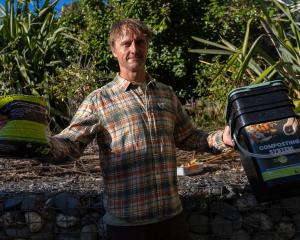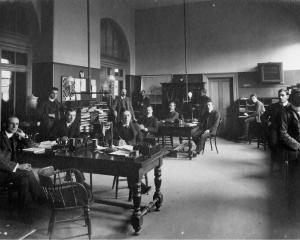Navy crews at sea are woken by a voice telling them to "wakey, wakey, wakey". At 6.50am. It is curiously amusing. For about two days.
After that time this "searider" found it a welcome relief from nights spent wide awake, hanging on to the side of the bunk to stop myself from falling out.

Civilian seariders are not so energetic so early.
Still recovering from the turmoil of the preceding night, I contort my (not usually very bendy) self out of my (only slightly larger than a coffin) bunk, clamber down (without stepping on my fellow seariders still nestled in the two bunks below) and stumble into clothing.
And so begins another day afloat on the Southern Ocean.
It is early December and Her Majesty's New Zealand ships Otago and Wellington are tracking towards the Subantarctic Islands, 660km south of Bluff.
The wake-up call is the first of many instructions the ship's crew of about 40 will daily receive over the ship's PA system as the navy's new deep-sea patrol vessels head south to test the ships and deliver a scientific expedition team to Campbell Island.
The Governor-General, the Minister of Conservation, some Department of Conservation and Ministry of Fisheries staff are along for the ride too.
After breakfast the crew begins its day of cleaning, watching blipping monitors, consulting computer screens, ironing, tidying, being briefed and debriefed, eating, studying, practising emergency drills, making reports, loading things on board and with seaboats, unloading, smoking, and doing PT (physical training), until they are tired enough to fall back into their bunks when the "darken ship" order is called.
Otago and Wellington are two of the Royal New Zealand Navy's new project protector fleet, and two of six new ships purpose-built for patrolling New Zealand waters.
The passage to Campbell Island is their first long-distance task.
In all, the Navy has 12 ships in its fleet, from warships to patrol vessels. All are based at Devonport.
The ships are high-tech and complicated beasts compared to navy ships of old.
On Otago and Wellington, people are usually only required in the engine room when one of the banks of computers begins to bleep urgently.
As it did when a wall-mounted box containing electrical wires in Otago's engine room moved in high seas, breaking a wire and leading to one engine being shut down.
People went in then, but the seas were too rough to reconnect the wire.
The ship continued on one engine, and as soon as the sea became calmer, the problem was sorted.
The advanced technology of a modern navy is not the only thing that is different.
There are women crew members, rubbish is not thrown over the side, smoking is restricted to the lower deck, and there is a well-used gym on board.
But some things don't change.
The crews live and work in cramped conditions, it's loud, there's a lack of privacy, people are nauseous and each day follows a routine.
It is breakfast time and it appears to be customary to start a day at sea with a cooked breakfast of eggs, beans and bacon.
The cooks on Otago will prepare 240 meals today - a mix of potatoes, pasta and meat, vegetables, salads, and always fruit with a dessert at night.
As the ship sways and shudders forward through the 4m waves of the Roaring 40s, one imagines it must take some doing to keep water in pots, food on stoves and knives a safe distance away from fingers.
There are other dangers on board.
Watch out for swinging hatch doors in 4m swells; showering without footwear; the slippery floor on the bridge; lying on your side in bed and opening a fridge during Sea State 6.
See what happens when you do that.
All chairs on board are lashed to the floor, non-slip placemats are provided with meals, tables are fixed, televisions screwed in or tied down and fridges are closed with a rubber stopper.
Up on the first deck, the officers and VIPs have their breakfast in the wardroom, a comparatively luxurious room housing a dining table with leather chairs and a plush lounge suite positioned both near the bar and around a large flatscreen TV.
Otago as the Octagon - and they eat at aluminium tables in the crew's messes.
Everyone eats the same meals. Lunch and dinner feature similar selections from curries to roast, to tacos or lasagne. The variety on offer was impressive.
For those who desire (or can stomach nothing else) lemonade ice-blocks and $1 cans of beer are some of what is on offer in the ship's canteen, the opening times of which are announced over the loudspeaker.
Before breakfast the unisex bathrooms (three showers, four toilets (featuring a remarkable super-suction aircraft flush action to who knows where, and four sinks) are awash with young men and women in nothing but towels and jandals.
Crew cabins range from single berth for the most senior officers to twin to three-berth or more for passengers. They are single-sex (I shared with five other women) with each pit (bed) fitted with privacy curtains.
Most of the single-, two- and three-berth cabins have en suite bathrooms.
After breakfast, the seariders, if they have any sense, take ablutions in a more relaxed manner.
The showers are hot and water pressure is strong.
In the crew's lounges, staff relax in comfy chairs, bean bags and play navy-fied versions of board games, or watch television - available even 700km south of the mainland, although you had better like TV ONE or Sky Sports as the entire ship's viewing choice is controlled from one controller in the bridge - or movies.
I managed to not throw up the whole time thanks to the procurement prior to the trip of every motion sickness potion known to man (scopolamine you are my new best friend) - but I am one of the lucky ones.
Even seamen with decades of experience, and the commanding officer of at least one of these two ships, are off-colour. And more than just a little. Everywhere you go people are talking about it.
Every sailor has a story, and back on (a still gently swaying) land, it is the first question every person asks.
What I found worse actually, was the still gently swaying land up to a week after I got home, and the way the ship's air conditioning really dried you out.
With the words "darken ship" comes the end of the working day for most people on the ships. Usually at sundown, the bright interior lights of the window-less ship are dimmed to a red glow and all aboard must stay inside, off the lower decks.
Most head for bed, some for a television fix, some for a quiet read. However, someone is taking care of business every minute of the day.
A group must work through the night on the bridge, others must be on call for maintenance and data readouts and blinking lights must be monitored constantly.
While life on board is busy and people are inescapable, the views are good, the crew is good-spirited, trusting and they enjoy each other's company.
And everyone is proud of their ship and more than willing to tell you about it.
They are really part of a little community and they have worked out how to deal with that and all it entails.
Good on them, and thanks for the ride.
TOMORROW: Wildlife on Campbell Island












